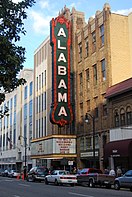
Back Área metropolitana de Birmingham–Hoover Spanish Grande Birmingham Portuguese Zona metropolitană Birmingham–Hoover Romanian Birmingham-Hoover-Cullman Combined Statistical Area Tagalog برمنگھم میٹروپولیٹن علاقہ، الاباما Urdu
Greater Birmingham | |
|---|---|
| Birmingham, AL Metropolitan Statistical Area | |
|
Clockwise from top: Downtown Birmingham, Alabama Theatre in Downtown Birmingham, Old Mill in Mountain Brook, Aerial picture of Samford University in Homewood, Vulcan statue in Birmingham | |
 | |
| Country | |
| State | |
| Largest city | |
| Principal cities | - Hoover - Vestavia Hills - Alabaster - Homewood - Trussville - Bessemer - Talladega - Sylacauga - Cullman |
| Area | |
• Total | 11,830 km2 (4,566 sq mi) |
| Population (2020) | |
• Total | 1,115,289 |
| • Rank | 50th |
| • Density | 84/km2 (217/sq mi) |
| GDP | |
| • MSA | $79.098 billion (2022) |
| Time zone | UTC−5 (CST) |
| • Summer (DST) | UTC−4 (CDT) |
| Area codes | 205, 659 |
| Website | www |
The Birmingham metropolitan area, sometimes known as Greater Birmingham, is a metropolitan area in north central Alabama centered on Birmingham, Alabama, United States.
As of 2023[update], the federal government defines the Birmingham, AL Metropolitan Statistical Area as consisting of seven counties (Bibb, Blount, Chilton, Jefferson, St. Clair, Shelby, and Walker) centered on Birmingham.[2] The population of this metropolitan statistical area as of the 2020 census was 1,180,631, making it the 50th largest metropolitan statistical area in the United States as of that date.
The seven counties in the Birmingham metropolitan statistical area are combined with the Cullman micropolitan area (Cullman County) and the Talladega–Sylacauga Micropolitan Statistical Area (Talladega County and Coosa County) to form the federally defined Birmingham–Cullman–Talladega, AL Combined Statistical Area.[2]
According to the United States Census 2020 census, the combined statistical area has a population of 1,415,988. It is the 42nd largest population sub-region in the United States, and the largest population region in Alabama, constituting roughly 1/4 of the state's population. It is the largest population region in Central Alabama. The northern counties of the Birmingham metro area specifically Blount and Cullman are also part of the North Alabama region also known locally as the Tennessee Valley and are overlapped by the much larger Birmingham metropolitan area despite its proximity to the nearby Huntsville metro. Nearby counties Tuscaloosa, Etowah, and Calhoun, while not officially a part of Greater Birmingham, contribute significantly to the region's economy. The Birmingham media market covers these counties as well. According to the List of metropolitan areas of Alabama, Birmingham is the largest urban area and metro in Alabama. Birmingham is part of the Piedmont Atlantic Megaregion containing an estimated 19 million people, while many residents also consider themselves part of the Deep South. It is classified as Southeast by the U.S. Census and also falls in the geographic area of the Upland South due to its location at the southern terminus of the Appalachian foothills. The entire MSA and CSA are within the congressional Appalachian Regional Commission's definition of Appalachia.
- ^ "Total Gross Domestic Product for Birmingham-Hoover, AL (MSA)". Federal Reserve Economic Data. Federal Reserve Bank of St. Louis.
- ^ a b "OMB Bulletin No. 23-01, Revised Delineations of Metropolitan Statistical Areas, Micropolitan Statistical Areas, and Combined Statistical Areas, and Guidance on Uses of Delineations of These Areas" (PDF). United States Office of Management and Budget. July 21, 2023. Retrieved July 25, 2023.




